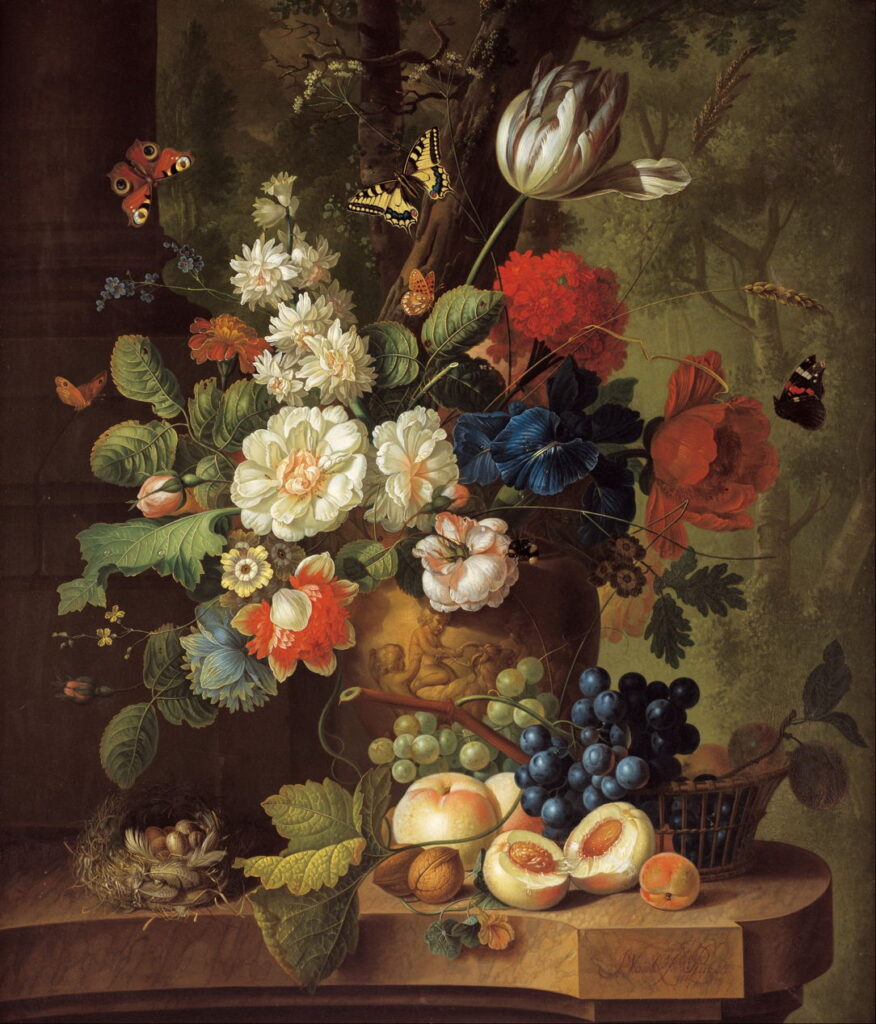Reading visual art: 174 Butterfly, narrative and symbolic

Butterflies are now most strongly associated with their beauty, fine summer weather, and the transience of their existence. In visual art, they have other interpretations that seem strange today. This article and its sequel tomorrow try to unravel some of those, starting with oddest by far.
Cornelis van Haarlem (1562–1638), The Fall of the Titans (1588-90), oil on canvas, 239 x 307, Statens Museum for Kunst (Den Kongelige Malerisamling), Copenhagen, Denmark. Wikimedia Commons.
Cornelis van Haarlem’s The Fall of the Titans from 1588-90 might seem a strange painting in which to find butterflies. This shows the classical myth in which the gods have defeated the Titans who preceded them. As a result the Titans fell from the heavens and were imprisoned in Tartarus, or Hell, as shown here. It’s claimed that flying insects, including butterflies, were associated with the fire of the underworld, although the two butterflies and one dragonfly here appear quite incongruous.
Dosso Dossi (–1542), Jupiter, Mercury and Virtue (1524), oil on canvas, 111.3 x 150 cm, Zamek Królewski na Wawelu, Kraków, Poland. Wikimedia Commons.
Another early painting of butterflies is also unusual. Dosso Dossi shows the senior of the classical gods painting butterflies in a pseudo-Christian act of creation in his Jupiter, Mercury and Virtue from 1524. The underlying myth stems from a quarrel between Virtue and Fortune, a case brought by Virtue to Jupiter. But he is too busy painting the wings of butterflies, so Mercury tells her to wait before pleading her case. Jupiter’s painting is so real, like that of Apelles, that as he completes each butterfly it takes life and flies off. Behind him is a rainbow providing the brilliant colours for his painting, making it an allegory of painting as well.
Edward Poynter (1836–1919), Psyche in the Temple of Love (1882), oil on canvas, 66.3 x 50.7 cm, Walker Art Gallery, Liverpool, England. Wikimedia Commons.
Edward Poynter’s painting of Psyche in the Temple of Love from 1882 tells a story from classical mythology that has been painted with butterflies on several occasions. Cupid has fallen in love with Psyche, and takes her to the Temple of Love where he visits her each night, but never in daylight. Here Psyche is whiling away the daytime, holding a sprig out to attract a butterfly as her attribute, although the common and prosaic small white rather than anything more exotic. However, Psyche’s enemy Venus is not far away, as shown by the doves in the temple behind her.
Carl Spitzweg (1808–1885), The Butterfly Catcher (c 1840), oil on panel, 31 × 25 cm, Museum Wiesbaden, Wiesbaden, Germany. Wikimedia Commons.
By the early nineteenth century, Europeans were travelling overseas to look for exciting new species of butterfly. Carl Spitzweg’s The Butterfly Catcher from about 1840 shows every hunter’s dream: discovering the largest, most spectacular butterflies ever seen. Compare the size of the hunter’s net with the unrealistically large butterflies in the foreground.
Winslow Homer (1836–1910), Butterflies (1878), oil on canvas mounted on masonite, 95.9 x 61 cm, New Britain Museum of American Art, New Britain, CT. Wikimedia Commons.
Winslow Homer’s Butterflies from 1878 shows a young woman hunting eastern tiger swallowtail butterflies with her net. This swallowtail species is widespread in the eastern USA, and related to the Old World swallowtail found across Europe. She’s carrying a box in which to place her specimens, in which they’d be killed, ready to mount in a glass cabinet. Collecting butterflies was considered sufficiently ladylike, because of their beauty, while less aesthetically satisfying insects such as beetles were left to male entomologists.
Sophie Gengembre Anderson (1823–1903), Take the Fair Face of Woman, and Gently Suspending, With Butterflies, Flowers, and Jewels Attending, Thus Your Fairy is Made of Most Beautiful Things (1880), oil on canvas, dimensions not known, Private collection. Wikimedia Commons.
Sophie Anderson entered the faerie painting sub-genre with Take the Fair Face of Woman, and Gently Suspending, With Butterflies, Flowers, and Jewels Attending, Thus Your Fairy is Made of Most Beautiful Things from 1880. The title is taken from some verse allegedly by Charles Ede, although the only literary person of that name who I can identify was born long after this work was completed. Not only are there butterflies adorning this fairy’s hair, but she also appears to have butterfly wings.
The ephemeral lives of butterflies made them a popular candidate for vanitas paintings expressing a weariness of earthly life.
Jan Sanders van Hemessen (1500–1579), Vanitas (c 1535-40), media and dimensions not known, Palais des Beaux-Arts de Lille, Lille, France. Wikimedia Commons.
The first of those started to appear in the early sixteenth century. In Jan Sanders van Hemessen’s Vanitas from about 1535-40, an androgynous angel with butterfly wings cradles a human skull with fragmentary Latin inscriptions. Those wings were modelled after the swallowtail butterfly.
Artist not known, Follower of Hieronymus Bosch, Christ among the Doctors (c 1545), oil on oak panel, 77.5 x 60.4 cm, Private collection. Wikimedia Commons.
A few years later, an anonymous follower of Hieronymus Bosch painted Christ among the Doctors (c 1545), with a large butterfly settled in the foreground.
Many other paintings of butterflies simply represent their beauty.
Pisanello (1395–1455), Portrait of a Princess (Ginevra d’Este) (1435-49), tempera on wood, 43 x 30 cm, Musée du Louvre, Paris. Wikimedia Commons.
Pisanello’s egg tempera Portrait of a Princess, showing Ginevra d’Este in 1435-49, surrounds her with flowers and four butterflies. The two on the left are red admirals, and one of the right is a swallowtail, two of the larger and more spectacular species that are abundant in southern Europe.
Nicolaes de Vree (1645–1702), A Forest Floor Still Life with Flowering Plants and Butterflies (date not known), oil on canvas, 112 x 88.5 cm, location not known. Wikimedia Commons.
For their familiarity, bright colours, and natural beauty, butterflies were popular in the Dutch Golden Age, particularly in smaller paintings such as still lifes destined for the collector’s cabinet. Nicolaes de Vree’s undated A Forest Floor Still Life with Flowering Plants and Butterflies from the latter half of the seventeenth century, is a fine example of a painting that goes beyond the normal still life and depicts a more natural scene.
Jan van Os (1744–1808), Flowers (c 1780), oil on wood panel, 70.5 x 61 cm, Art Gallery of South Australia, Adelaide, Australia. Wikimedia Commons.
Jan van Os’s Flowers from about 1780 is a much later example, featuring a peacock, swallowtail and red admiral. Each would have been painted from a dead specimen in a collection; collections became popular as the Age of Enlightenment encouraged the better-educated to take an active interest in developing sciences such as entomology.




